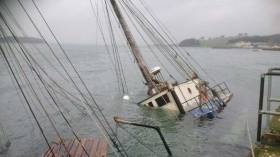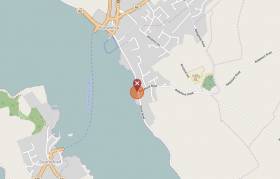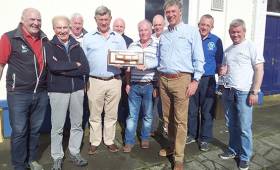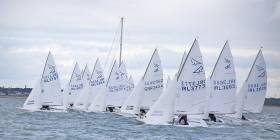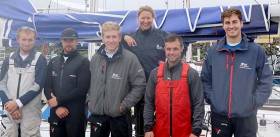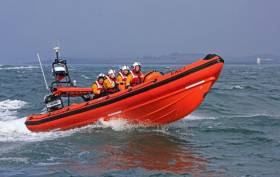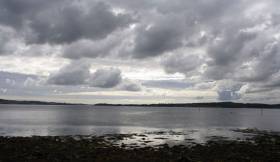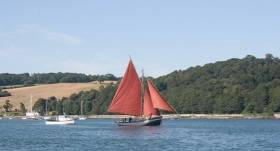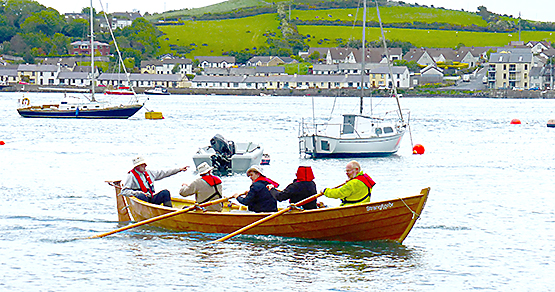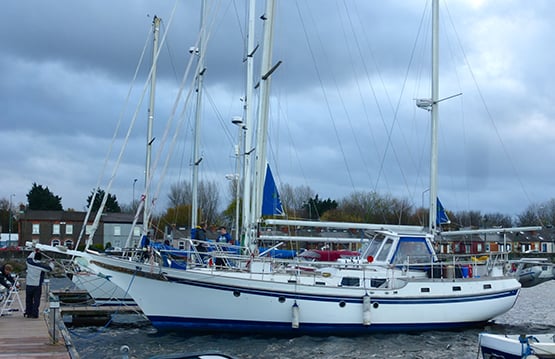Displaying items by tag: Strangford Lough
'Urgent' Assistance Sought to Raise Sunken Schooner in Portaferry
Afloat.ie has received an 'urgent' appeal for Tall Ship enthusiasts to help with a sunken 100–foot schooner in Portaferry Harbour. William Mulhall says he wants to return the 1935–built vessel to her 'former glory' but is seeking the assistance of a 'Tall Ship enthusiast to raise her and give her a refit'.
As Afloat.ie previously reported the schooner contained up to 1,000 litres of diesel fuel and had been moored in the harbour for some time, up to 18 months according to local reports.
BBC news says although a diesel spill in the area will clear up relatively quickly, the salvage operation to move the Regina Caelis could take months.
It is understood specialist equipment that is capable of bearing the weight of the boat, which is more than 200 tonnes, will need to be brought in.
Mulhall appealed for assistance via email: 'I have a tall ship sunk on the 27/1/17 in 20 foot of water still tied to the harbour and lying on her starboard side, in Portaferry, Co.Down, Northern Ireland
The Schooner Regina Caelis built in 1935 is 108ft long with a 40ft bow sprit and 10 sails, she has 3 masts and an engine BMA fitted in 1955.
I urgently need a Tall Ship enthusiast to raise her and give her a refit on slip and return her to former glory. I am open to ideas, partners, groups and shares'.
Contact details supplied : [email protected] or telephone at: 02844841301
Sunken Boat Sparks Strangford Lough Fuel Spill Fears
#StrangfordLough - Leaking fuel from a submerged boat in Strangford Lough has promoted environmental concerns, as BelfastLive reports.
The three-masted vessel, which has been moored in Portaferry Harbour for some time, crashed into the quay, and sank on Friday (27 January).
And there are now fears of a major pollution incident after some of the 1,000 litres of diesel still on board began leaking into the lough.
The nearby Exploris Aquarium has among others taken the precaution of closing its intake from Strangford Lough, which is a Special Protection Area for marine wildlife.
BelfastLive has more on the story HERE.
Tied Up New Strangford Ferry As Ramps Will Not Allow Cars to Disembark
#Strangford - Strangford Lough's new £6m carferry as previously reported on Afloat remains tied up in County Down because problems with the ramps mean vehicles are unable to drive off it.
The ramps on the vessel reports BBC News which was specifically built for the Strangford Lough crossing, will have to be modified before it can be used.
As it stands, cars would be unable to disembark from the vessel at high tide.
The Stormont Executive paid £5.7m for the bespoke ferry.
It is intended for use on the half-mile crossing between Portaferry and Strangford.
During recent sea trials in Strangford Lough, it emerged that the ramps on the ferry do not drop low enough to allow cars to drive off them when the ferry docks at high tide, as the ramps stop before they reach the slipway.
For much more including photos of the newbuild's ramps click here.
Van Crashes Into Strangford Lough
#StrangfordLough - A delivery driver sustained minor injuries after his van crashed into Strangford Lough on Friday evening, according to BelfastLive.
The van reportedly spun off the road near Newtownards on a stretch of Portaferry Road known for similar incidents in recent months.
Last December an Ulsterbus crashed through a wall onto the beach below, as previously reported on Afloat.ie.
Just weeks later, one person had to be freed from a car that crashed through a wall on the same road at low tide.
Strangford Lough didn’t disappoint the Irish Flying Fifteen fleet at the weekend with the usual mixture of sunshine, wind, no wind, tides in both directions, thunder, lightning and hail stones as big as marbles and a bit of sailing thrown into the mix!
The Flying Fifteen Northern Championships was hosted by Portaferry Sailing Club at the weekend and was won by former World Champion and guest UK helm Charles Apthorp with Alan Green (NYC) crewing. Ian Mathews & Keith Poole were second with Dave Gorman & Chris Doorly (NYC) a close third.
On Saturday the wind settled to be reasonably steady from the sw and there were three races. In race 1 Gorman was out of the blocks quickly and led all the way, Mathews was second with .McCleery third and Apthorp fifth after having to do penalty turns. The wind was holding and the right was generally favoured, Apthorp won Race 2 with Mathews second again after gybsetting on the run to get inside Gorman who finished third with Brien Willis fourth. Shortly after Race 3 got going, Gorman got stuck on the second row as most sailed on, surprisingly no one was over the line. Gorman cut out to the right to get clear wind and work the shifts and came in second behind Apthorp at the weather mark. It was a triangle course and Apthorp went too high looking for the mark allowing Gorman to take the lead. It was short lived as Apthorp passed him at the gybe mark, a bit of rustiness in the crewing! It is strange that triangles are been taken out of club racing and then when we go to regional events we end up doing something we don’t practice, we live and learn!. On to the next beat, Gorman was flying and took the lead again but again it was not to last downwind. Apthorp won by a couple of boat lengths from Gorman with McKee and Darren Martin third and Mathews fourth. Over night it was Gorman just ahead of Apthorp with Mathews a close third- all to play for on Sunday with two races and a discard to come into the equation.
Sunday started off with little or no wind, ir was difficult for the PRO and each time he set a course and started the sequence it shifted and the AP went up. Eventually he started with the zephre of wind from Killleagh in the west. It was adrift up the beat, at one stage Ben Mulligan was flying over the glass like pond, soon spinakers went up and yet the ‘race’ went on, Apthorp, Mathews, Willis and Gorman all arrived at the weather . . or was it the leeward mark together but then it changed into a run as the wind filled in, Andy & Rory Martin who are back in the fleet were flying out on the right. The course was strangly shortened while there was wind, you could have thrown a blanket over the first six boats but it was Apthorp who continued his good form to win, Willis was second, Mathews third, the Martin boys fourth and Gorman suffered in sixth place.
The forecasted wind from the south slowly made its way up from the south and Race 5 got going after the course was reset. Gorman, the holder, still had a chance if he won the race but it was not to be as he had a poor start and got stuck in a pile up at the committee boat end, unfortunate as Apthorp also had a poor start. On the first beat right seemed to pay with McKee leading from Shane McCarthy and the Martin brothers and Ian Smith. The second beat the left paid, Apthorp was making inroads and moved to third, that was the way it was to stay and this was enough for Apthorp & Green to deservedly win the event which is the oldest Flying Fifteen trophy in the land. As the fleet headed back towards Portaferry the heavens opened with thunder and hailstones pounding on to the frozen crews, it was a sight and sound to behold!
As this year is the 30th anniversary of the foundation of the Flying Fifteen Association of Ireland its first President and Flying Fifteen stalwart Jim Rodgers presented the prizes to the Gold fleet while Colin Coffey also a member of the original committee presented the prizes to the Silver and Bronze Fleet winners.
Special thanks to the PRO and his team who did a great job in really difficult conditions, to Shane, Peter, Jo and all the local sailors and volenteer’s who made the event happen. It’s always a pleasure to go to Portaferry which is one of the friendliest clubs in the country. Those who didn’t travel missed out on a great weekend.
The Flying Fifteen Northern Championships will take place in Strangford Lough this weekend and will be hosted by Portaferry Sailing Club. There should be some great racing as up to twenty boats are expected in what is the first regional event of the season.
Favourites will be UK guest helm Charles Apthorp sailing with Alan Green (NYC) but current holders and National champions Dave Gorman & Chris Doorly (NYC) as well as local sailors Shane McCarthy, Andy McCleery, Brian McKee and Brian Willis among others will also be looking to have a say in where the silverware goes.
This year is the 30th anniversary of the foundation of the Flying Fifteen Association of Ireland and its first President and Flying Fifteen stalwart Jim Rodgers will be presenting the prizes to mark the occasion.
Northern Ireland solo offshore sailor Andrew Baker sailing Artemis 64 says he's learned to 'forget the small stuff in anticipation of bigger challenges' as he prepares for today's Solo Normandie that offers him and his fellow Artemis team–mates the chance to check out the start of this summer’s Figaro course
“I feel in a good position. I’m well rested and have been able to take stock of what I need to work on for this race. The boat has had some repairs and I’ve done some work to the hull, so I’m hoping we will be a little bit quicker, he told Afloat.ie
The Artemis Offshore Academy sailors Will Harris, Mary Rook, Hugh Brayshaw, Alan Roberts, Andrew Baker and Robin Elsey today set sail on the Solo Normandie 2016.
This is the final warm-up race ahead of the Solitaire Bompard Le Figaro in June for Harris, Rook, Brayshaw and Baker. Elsey and Roberts will race again in the mainly inshore ALL MER CUP in two weeks time.
The Normandie offers a 284-nautical mile tidal and rocky coastal course from Granville to Le Havre in France – with a finish close to Deauville – the start of this year’s Solitaire.
“There’s a huge tidal element to this race, so I think it will be a great practice run for the Solitaire this year, which follows a more coastal route. Short tacking through rocks along the coast will be great practice.
“I’ve learned a lot over the last two races. I’ve learned that I can be quick, but I’ve also learned that I can’t forget the small stuff in anticipation of the bigger challenges.
“I’ve not looked at the forecast in detail for this race on purpose as every grib file I’ve downloaded has been different. Sometimes you can have too many strategies in your head and that can effect the outcome of your race if you’re faced with something unexpected.” says Baker.
“It’s an opportunity to race on a super-tidal course, where we can expect to learn the wind effects along a coastline ahead of the Solitaire,” said Harris , Rookie division winner of both the Solo Concarneau and the Solo Maître Coq. “It’s such a tidal area that we may have to race between a lot of rocks, even anchor at times, so getting used to that over the next three days will be my main focus.”
With just 8-10 knots of breeze forecast for the start of the race, organisers delayed setting the course until last night.
This last-minute decision, combined with ever-changing weather forecasts pre-race, has meant planning for the Solo Normandie has been difficult for the 15 skippers taking part – particularly for the six rookie sailors, among them Rook , Harris and Brayshaw .
“Planning for the race has been pretty vague with changing weather predictions and the course set only last night,” said Brayshaw before leaving the dock. “Because of that I’ve been focusing on the things that I can control – the boat and myself. The rocks and tides we’ll come up against in this race make for a unique course.”
Despite a light, flat and drizzly start, conditions are expected to build towards the end of the race as Rook, one of four female sailors competing, explained this morning.
“It’s going to be a rainy and foggy start,” she said. “But I like lighter winds so the first half should be good for me. The end of the race is going to be quite a challenge though – 30 knots of wind against tide in the middle of the night and having to change sails – I’m not really looking forward to that.”
For Roberts , who was the top British Solitaire finisher in 2015, the strong tidal areas of the north-western French Atlantic coast will be the key ingredient in this race.
“The Solo Normandie will be a hard one because of the strong currents,” he said. “There will be times during the race where the back end of the fleet will be able to reconnect with the front, and others where the front will be able to pull away from the rest. It will be very tricky because of that and nothing will be certain until we cross the finish line.”
Of the 15 competitors, the experienced Figaro campaigner Alexis Loison (Groupe Fiva) will likely be the one to beat, with Academy Alumni Roberts, Baker and Elsey (Artemis 43) all in with a good chance of a top five finish.
Within the Rookie division, Harris is looking to continue his winning streak, going for his third consecutive Rookie division victory ahead of the Solitaire Bompard Le Figaro.
“I’m aiming for the top Rookie again,” he said. “I’ve previously struggled with light wind sailing, but we had quite a lot of it in the last race and I found myself being quite fast – so I’m looking forward to testing myself again. There is also quite a lot of upwind sailing in this race, which I would say is one of my strengths, also sailing in bigger breeze. I’m looking forward to it.”
e with lots of tide and you really have to think about your strategy in that situation.
“In the first two races, I found it quite difficult being on my own, and not having any help if a situation turns bad. I think the biggest thing I’ve learned is that it’s always just going to be me, so not to get too stressed or emotional when things do go bad. Just try to fix it and move onto the next thing.
“I’m not worried about the changeable forecast, as everyone is in the same situation. I’m just going to make sure I’m properly set up for light winds and then ready for the heavier breeze when and if it comes.
“The plan for the race has been pretty unclear, changing weather predictions and the course set only the night before, so I’ve been focusing on the things that I can control – the boat and myself.”
“It’s an opportunity to race on a super-tidal course, where we can expect to learn the wind effects along a coastline ahead of the Solitaire. It’s such a tidal area that we may have to race between a lot of rocks, even anchor at times, so getting used to that over the next three days will be my main focus.
“I’d also like to aim for the top Rookie again, with only 15 competitors taking part in this race I can’t really say where I’ll fit in in the overall rankings. I’ll just sail as fast as I can and learn as much as I can ahead of the Solitaire.
“I tired myself out very quickly in the last race, so I’m going into this next race aware that I need to keep on top of my sleep and make sure I don’t burn out. This is going to be really difficult given the nature of the course. It will difficult to find opportunities to sleep between rocks and tidal areas.
“The weather forecast is light on the first day which was has meant race organisers have had trouble setting the course. I’ve previously struggled with lightwind sailing, but we had quite a lot of it in the last race and I found myself being quite fast – so I’m looking forward to testing myself again. There is also quite a lot of upwind sailing, which I would say is one of my strengths, also sailing in bigger breeze. I’m looking forward to it.”
#RNLI - The volunteer lifeboat crew at Portaferry RNLI responded to a launch request from the coastguard yesterday morning (Saturday 30 April 2016) to assist two men on board a yacht stranded on rocks in Strangford Lough, Co Down.
Portaferry's inshore Atlantic 85 launched at 9.22am and the volunteer crew were quickly on scene at Long Rock, just off East Down Yacht Club, 10 minutes later.
Weather conditions at the time was cloudy with good visibility, a Force 3 north westerly wind and calm sea.
When the RNLI crew arrived, they fixed a line to the 28ft yacht and towed it off the rocks.
Once their yacht was free, the two men on board proceeded to East Down Yacht Club accompanied by the Portaferry lifeboat crew, who remained with the yacht until it was safely returned to the pontoons at the yacht club.
After the callout, Portaferry RNLI lifeboat operations manager Brian Bailie said: "It has been a busy few months for the crew in Portaferry and we were delighted to have been able to assist these two men who had run into some difficulty.
"We are now entering our most busy time of year and we would urge everyone taking to the water to make sure that they prepare properly and check that all equipment is tested and in good working order."
The RNLI offers sea safety advice online at RNLI.org/RespectTheWater
Missing Diver Found Safe In Strangford Lough
#Diving - The UK Coastguard received a call just after 4.10pm yesterday afternoon (9 April) from a member of public reporting that a diver had not surfaced as expected in Strangford Lough near Ringhaddy, Co Down
Coastguard rescue teams from Portaferry and Bangor, the Portaferry RNLI lifeboat, the PSNI helicopter and the Irish Coast Guard's Rescue 116 helicopter based at Dublin were all sent to the area for the search.
Luckily the diver was found on the shore by local residents shortly after the coastguard were altered.
The Irish Coast Guard helicopter landed, with assistance from the UK Coastguard rescue teams. The diver was checked over by the on-board paramedic and after advice from a specialist doctor the diver was given the all-clear and allowed to make his own way home.
Graham Edgar, senior maritime operations officer with Belfast Coastguard, said: “This is a great outcome for all involved, the other diver’s in the group did exactly the right thing, they called us as soon as they realised he was missing.
"Fortunately the diver was found safe and well. We would urge all divers, as this diver did, to let someone know where they are planning to dive, when they are planning to come back and if possible dive within a group.
"Also keep a close eye on the weather and sea conditions and always dive within your limits."
Portaferry Sails & Sounds Will Broaden Life In The Narrows
The revival of Portaferry in Strangford Narrows as a mid-summer focal point for classic and traditional sail afloat, combined with traditional music and festivities ashore, is set to take place from Thursday June 16th to Sunday June 19th this year with the newly branded and re-vamped Portaferry Sails & Sounds Festival 2016 writes W M Nixon
Time was when the highlight for traditional sailors at Portaferry, where the tides sluice with some strength in and out of Northern Ireland’s saltwater lake of Strangford Lough, was racing by restored Galway hookers - they came north in substantial numbers in late June from their home ports in the greater Dublin area. But it is the new Dublin-Galway motorway – of all things - which has seen numbers of traditional craft around Dublin Bay decline as they migrated back to their newly-accessible true heartlands around Galway Bay, such that now if you want to be sure to see hookers - including many Dublin-owned ones - racing in strength, you need to go Macdara’s Island off Connemara for St MacDara’s Day – July 16th – or to Kinvara at the head of Galway Bay for Cruinniu na mBad, which in 2016 is August 19th to 21st.
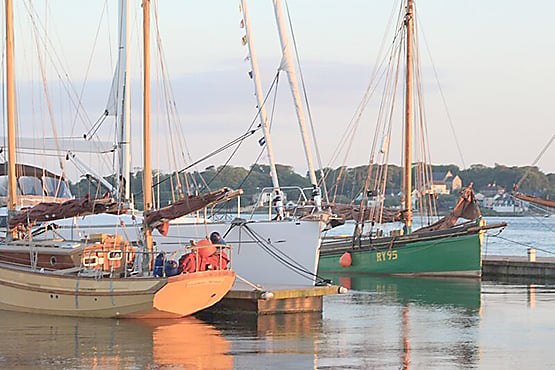
Alan and Irene Aston’s Cornish Crabber Golden Nomad in Portaferry Marina, while beyond with bowsprit housed is Joe Pennington’s famous Manx Longliner Master Frank
But there are other places in the Irish Sea where traditional craft and interesting old gaffers are to be found, notably in North Wales and particularly in the Isle of Man, where Joe Pennington has restored the last Ramsey Longliner – Master Frank – into superb sailing conditions, while Mike Clark continues to maintain the Manx nobby White Heather under her classic labour-intensive lugger rig.
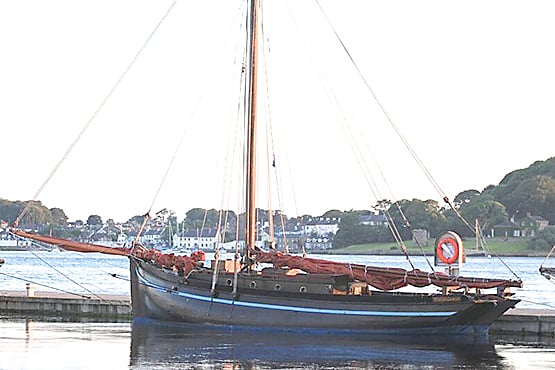
Naomh Cronan in Portaferry Marina
As well of course, the big Clondalkin-originated Galway Hooker Naomh Cronan continues to make the Irish Sea her home base, sailing from Poolbeg in Dublin, and there’s an increasing number of classic restored gaff yachts at many centres all round the Irish Sea and the Firth of Clyde, which link together through the Old Gaffers Association. This will provide a real increase in the fleet which this year will make Portaferry a major happening again, the interest further heightened by the presence of Strangford Lough’s fleet of nine-plus Iain Oughtred-designed four-oared skiffs, which have a regular racing programme in the lough.
The Strangford Village Rowing Club’s skiff in action at their home port, with Portaferry just across the narrows. Photo: W M Nixon
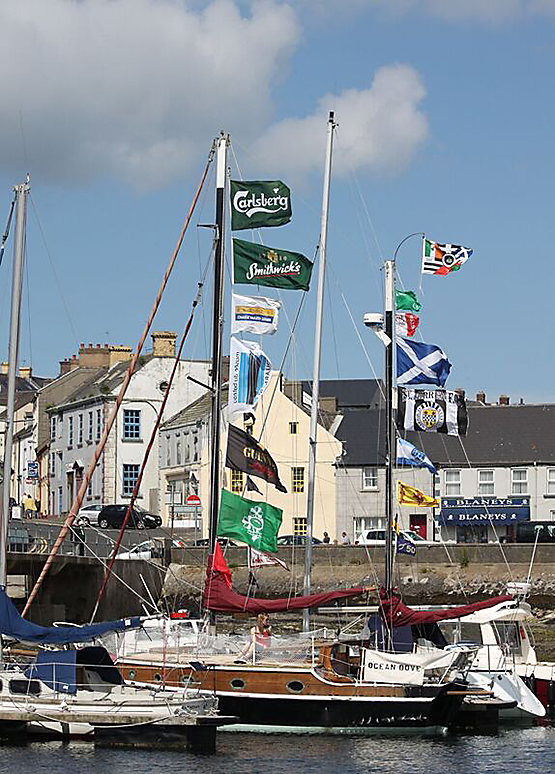
Gary Lyons’ ketch Ocean Dove in party mode in Portaferry Marina
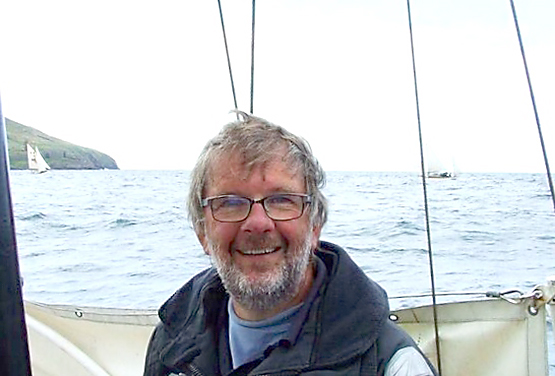
Adrian “Stu” Spence, one of the main movers and shakers behind the new-look Portaferry Sail & Sounds 2016 in June.
The two powers in the land who are making sure it all takes off are Garry Lyons of the Northern Ireland Old Gaffers Association, skipper of the vintage ketch Ocean Dove, and another northern sailor, the legendary Adrian “Stu” Spence, who in 2014 finally parted from his incredibly old Pilot Cutter Madcap (she may have dated back as far as 1873), which over many seasons he’d cruised to places as distant and different as Greenland and Spain.
In the Autumn of last year he came into Poolbeg with his new Mediterranean-acquired vessel, a rakishly clipper-bowed Vagabond 47 ketch which Skipper Spence currently refers to as “The Love Boat” – we look forward to learning of the official name in due course. The new ship was in Poolbeg in order to access the specialist talents whom Stu Spence has got to know during his long years with the Old Gaffers, in order to make the big ketch fit for anything before she finally goes on to her home mooring at Ringhaddy in Strangford Lough, and she’ll admirably fulfill the role of one of the flagships for Portaferry Sails and Sounds in June.
Stu Spence currently refers to his newly-acquired Vagabond 47 ketch – seen here in Poolbeg Marina – as “The Love Boat”. Photo: W M Nixon
Run jointly by the Northern Ireland Old Gaffers Association and Portaferry Sailing Club, Portaferry Sails & Sounds 2016 promises the perfect mixture of sport and spectacle, sailing and singing, and dancing and divilment to make the Midsummer Weekend pass merrily in the classic and traditional style.

Mike Clark’s traditionally-rigged Manxy Nobby White Heather from Peel is expected in Portaferry in June





























